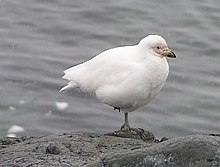White-faced sheathbill
| White-faced sheathbill | ||||||||||
|---|---|---|---|---|---|---|---|---|---|---|

White-faced sheathbill ( Chionis alba ) |
||||||||||
| Systematics | ||||||||||
|
||||||||||
| Scientific name | ||||||||||
| Chionis alba | ||||||||||
| ( Gmelin , 1789) |

The snowy sheathbill ( Chionis alba ) is a species from the family of sheathbills , a small family, which includes only two types. Unusual for a bird of the order plover-like are the plump physique and the short legs in relation to the body, so that the white-faced sheathbill is reminiscent of a chicken. The species breeds on some islands in the sub-Antarctic , north of the Arctic Circle .
Appearance
The white-faced vaginal beak reaches a height of 34 to 41 centimeters. The wing length is 23.4 to 26 centimeters, the wingspan, however, 74 to 84 centimeters. The weight varies between 460 and 780 grams. There is no noticeable gender dimorphism. Males just tend to be slightly larger than females.
The plumage of the whitefaced vaginal bill is completely white. White-faced vaginaries typically run quickly on the ground, nodding their heads like pigeons . This rapid head movement, followed by keeping the head still, helps you see better while running, as your eyes cannot be moved independently by muscles. These birds are generally not shy. They are not very vocal, a brief, raven-like croak is occasionally audible.
It can only be confused with the black-faced sheathbill belonging to the same family . This species differs from the white-faced vaginal beak by its dark face. However, the distribution areas of the two species do not overlap.
Distribution area
The white-faced sheathbill breeds on the rocky shores of sub-Antarctic islands such as South Georgia , the South Orkney Islands , the South Shetland Islands, and the Antarctic Peninsula . White-faced sheathbills, unlike the black-faced sheathbill, are migratory birds. Non-breeding white-faced sheathbills are seen in the Falkland Islands and southeastern South America. In the Falkland Islands in particular, they are close to human settlements. Occasionally they reach north-east Brazil as a stray visitor . Occasionally they follow ships and have already reached South Africa and even Europe on this route .
Way of life
Sheaths are omnivorous and pronounced kleptoparasites . They steal krill and fish from penguins and occasionally eat their eggs and downy chicks. Among the species of penguins whose main predators they are, include the Chinstrap penguins . They also eat carrion, feces, alken birds , invertebrates and, where available, human waste.
White-faced sheaths show a high level of loyalty to nesting sites and accordingly also enter into pair bonds that can last over several reproductive periods. They usually breed near penguin or cormorant colonies. The breeding season falls in the period October to March, the eggs are laid and incubated in the period December to January. Nestlings can be seen in January and February.
The nest is usually built in a cave or crevice. The clutch usually consists of two to three eggs. These are incubated for 28 to 32 days. The young birds fledge after 50 to 60 days.
supporting documents
literature
- Hadoram Shirihai: A Complete Guide to Antarctic Wildlife - The Birds and Marine Mammals of the Antarctic Continent and Southern Ocean , Alula Press, Degerby 2002, ISBN 951-98947-0-5 .
Single receipts
- ↑ a b Hadoram Shirihai: A Complete Guide to Antarctic Wildlife - The Birds and Marine Mammals of the Antarctic Continent and Southern Ocean . Alula Press, Degerby 2002, p. 253
- ↑ a b Hadoram Shirihai: A Complete Guide to Antarctic Wildlife - The Birds and Marine Mammals of the Antarctic Continent and Southern Ocean . Alula Press, Degerby 2002, p. 254
Web links
- xeno-canto: sound recordings - Snowy Sheathbill ( Chionis albus )
- Chionis albus inthe IUCN 2013 Red List of Endangered Species . Listed by: BirdLife International, 2012. Retrieved December 30, 2013.